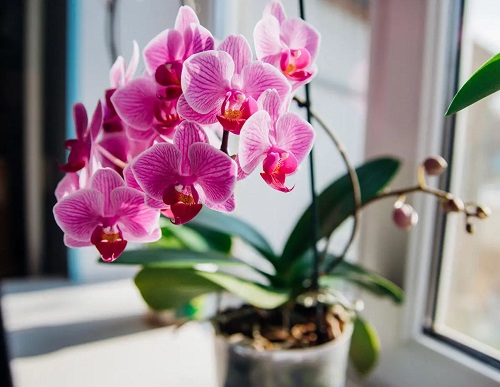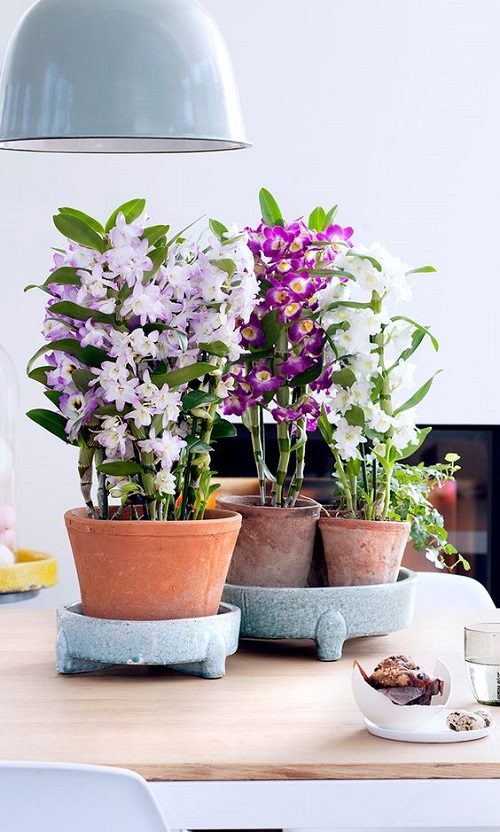Do Orchids Need Sunlight? Can they flower without it? If you have these questions in mind then this article is for you!
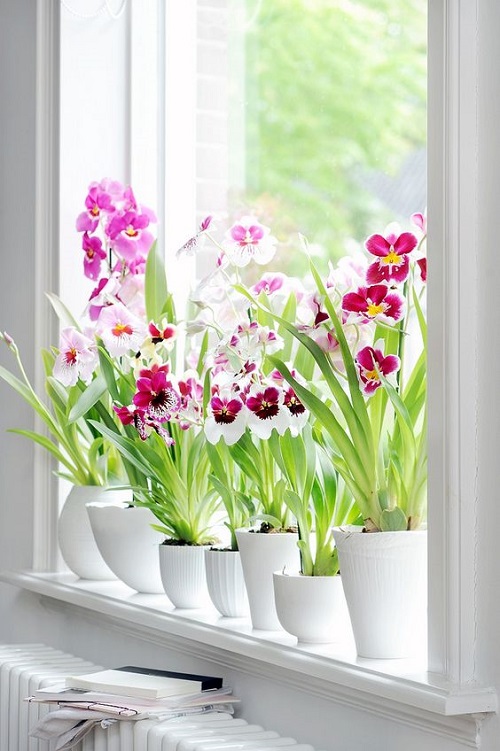
One of the most crucial and often misunderstood factors in orchid care is sunlight. Do Orchids Need Sunlight or are they happier in the shade? The answer might surprise you! From seasoned gardeners to curious beginners, read on as we demystify the sun-loving or sun-shy habits of different orchid varieties, equipping you with the knowledge to help your orchids flourish!
Best Types of Blue Orchids | Blue Orchid Meaning
Do Orchids Need Sunlight?
Yes, orchids generally require sunlight to flower. Photosynthesis, which is vital for plant growth and blooming, occurs when the plant is exposed to light. Without adequate sunlight, your orchid may grow leaves but fail to flower.
Can Orchids Thrive in Shade?
While orchids do require light, some varieties can tolerate lower light conditions better than others. For example, Phalaenopsis orchids are known for their ability to do well in lower light, making them suitable for indoor settings. However, even these “shade-tolerant” varieties need some indirect sunlight to thrive and flower.
Optimal Sunlight for Indoor Orchids
When growing orchids indoors, aim for a “Goldilocks” situation—not too much, but not too little. A north or east-facing windowsill is often ideal. You’re aiming for bright, indirect light; direct sunlight can burn the delicate leaves. Here’s how to gauge the right amount:
- Duration: 6-8 hours of indirect sunlight in the summer and about 4-6 hours in the winter.
- Intensity: Use sheer curtains to diffuse strong sunlight and prevent leaf burn.
- Color: Healthy orchid leaves should be a bright green. Dark green leaves might indicate too little light, while reddish or yellow leaves can signal too much.
How to Grow Orchids Without Sun
Growing orchids without direct sunlight can be a rewarding endeavor, especially if you have limited access to natural light. Here’s how to do it:
1. Choose the Right Orchid Variety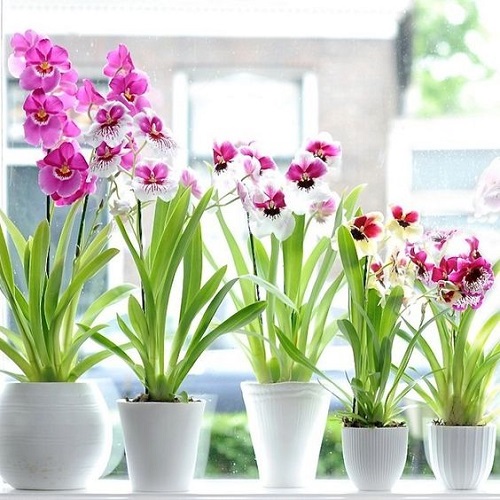
Opt for orchid species that are known to thrive in lower light conditions, such as Phalaenopsis, Paphiopedilum, or Dendrobium orchids. These varieties are more adaptable to indoor environments with limited sunlight.
2. Find the Ideal Location

Place your orchids in a spot where they can receive bright, indirect light. This usually means near a north or east-facing window. Sheer curtains can help filter the sunlight and prevent any direct rays from scorching the leaves.
Orchid leaves turning yellow? Find the solution here
3. Monitor Temperature and Humidity
Orchids also need the right temperature and humidity levels to flourish. Maintain a temperature range suitable for your orchid type (usually between 60-80°F or 15-27°C). To increase humidity, use a humidity tray or humidifier, and mist your orchids occasionally.
4. Use a Proper Growing Mix
Use a well-draining orchid potting mix to ensure the roots receive adequate aeration. Go for:
- Sphagnum Moss: Provides excellent moisture retention.
- Bark Chips (Pine or Fir): Allows for good drainage.
- Perlite: Increases aeration.
- Charcoal: Filters toxins and odors.
- Coconut Coir: Retains moisture and provides nutrients.
A common ratio is 4 parts bark, 2 parts sphagnum moss, 1 part perlite, and 1 part each of charcoal and Coconut Coir.
5. Water Wisely
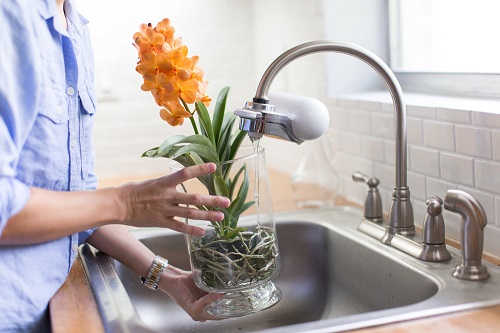
Orchids should not be overwatered. Stick your finger up to one inch into the growing medium. If it feels dry, it’s time to water. When you do water, soak the pot thoroughly, then let the excess water drain out. Never let the orchid sit in standing water.
Here are the common orchid growing mistakes you need to avoid
6. Fertilize Carefully
Phosphorus is crucial for bud development. Liquid fertilizers with a higher middle number in the N-P-K ratio (e.g., 10-30-20) promote flowering.
Dilute the feed to 1/4 of its strength and use it once in 3-5 weeks to promote growth and flowering. Stop fertilizing during winter months.
Do not throw away your dead orchids! Find out why here
Orchid Grow Lights
To promote growth and flowering, you can use grow lights for orchids.
Types of Grow Lights for Orchids
- Fluorescent Tubes: Ideal for beginners and low-light orchids. They are cost-effective and emit a balanced spectrum of light.
- High-Intensity Discharge (HID) Lights: These include metal halide and high-pressure sodium lights. They are more powerful but generate heat, requiring good ventilation.
- LED Lights: Highly efficient and long-lasting, LED lights come in full-spectrum varieties and are excellent for precise control over light intensity and wavelength.
- LCD Lights: Less commonly used in horticulture, LCD lights are more energy-efficient but may lack the spectrum range needed for optimal orchid growth.
Light Intensity
- Low Light Orchids: Species like Phalaenopsis and Paphiopedilum require around 1,000 to 1,500 foot-candles.
- Medium Light Orchids: Cattleya and Oncidium prefer 1,500 to 2,500 foot-candles.
- High Light Orchids: Vanda and Dendrobium can handle up to 3,000 foot-candles.
How to Use Grow Lights
- Placement: Position the lights 6 to 12 inches above the orchids.
- Duration: Most orchids require 10-14 hours of light per day.
- Rest Period: Ensure that your orchids have a dark period for at least 8 hours to mimic natural conditions.
LED vs. LCD
- LED Lights:
- Pros: Energy-efficient, long lifespan, full-spectrum availability, less heat emission.
- Cons: Higher initial investment.
- LCD Lights:
- Pros: Even more energy-efficient than LEDs.
- Cons: Limited spectrum availability, less commonly used for plant growth.
Recommended Grow Light Brands
- ViparSpectra: Known for high-quality LED lights with full-spectrum options.
- GE Lighting: Offers balanced fluorescent tubes suitable for orchids.
- Philips: Provides a range of HID and LED options for varying light requirements.
Orchid Varieties That Don’t Need Much Sunlight
These varieties have mastered the art of thriving in low-light conditions, making them perfect companions for your indoor oasis.
- Phalaenopsis ‘Little Star’: The ‘Little Star’ Phalaenopsis orchid is a petite beauty that can thrive without direct sunlight. Its compact size and striking white and purple flowers make it a perfect fit for small spaces and low-light environments.
- Paphiopedilum ‘Green Dragon’: The ‘Green Dragon’ Lady’s Slipper orchid is an exotic choice for low-light areas. Its distinctive green and brown blooms add a touch of the rainforest to your indoor garden, and it’s known for adapting well to dimmer conditions.
- Dendrobium ‘Berry Oda’: The ‘Berry Oda’ Dendrobium orchid boasts vibrant purple-pink flowers and is surprisingly easy to grow without direct sunlight. Its slender canes gracefully arch, making it an elegant addition to any room.
- Oncidium ‘Golden Shower’: The ‘Golden Shower’ Dancing Lady orchid is known for its lively, yellow blooms. It’s a low-light champ, thriving happily indoors without the need for direct sunlight.
- Zygopetalum ‘Blue Blazes’: ‘Blue Blazes’ Zygopetalum orchids offer enchanting blue and green flowers and have a knack for thriving in medium to low light conditions. Their unique coloration makes them a conversation piece in any setting.
- Masdevallia ‘Orchidglade’: ‘Orchidglade’ Masdevallia orchids thrive in cooler, low-light environments. Their curious, colorful blooms resemble miniature flying birds and add a touch of whimsy to your indoor garden.
- Ludisia discolor ‘Jewel Orchid’: The ‘Jewel Orchid’ is celebrated for its striking foliage, which thrives without direct sunlight. Its velvety leaves feature deep maroon stripes, making it a captivating addition to any low-light setting.
Check out the best orchid planter ideas here
Do Orchids Need Sunlight – FAQs
1. Do Orchids Need Sunlight or Just Light?
Orchids need light to thrive, but they don’t necessarily require direct sunlight. Most orchids prefer bright, indirect light, similar to the light filtered through a sheer curtain.
2. Do Indoor Orchids Need Sunlight?
Indoor orchids do need light to grow and flower, but they can thrive without direct sunlight. Many orchid varieties are well-suited to the lower light conditions found indoors. Placing them near a window with filtered or diffused sunlight or under artificial grow lights can provide the necessary light for healthy growth.
Check out our article for making DIY orchid potting mix recipes here
3. Do Orchid Flowers Need Sunlight?
Orchid flowers, like the rest of the plant, benefit from proper lighting. While the flowers themselves don’t have specific light requirements, they develop best on orchid plants that receive adequate light. Bright, indirect light ensures that the orchid can produce vibrant and long-lasting blooms.
4. Do Orchids Benefit from Seasonal Light Changes?
Yes, many orchids appreciate slight seasonal variations in light. Mimicking the natural light changes of their native habitats can help stimulate blooming. Providing a bit more light during the spring and summer, and reducing it slightly in the fall, can encourage flowering.


